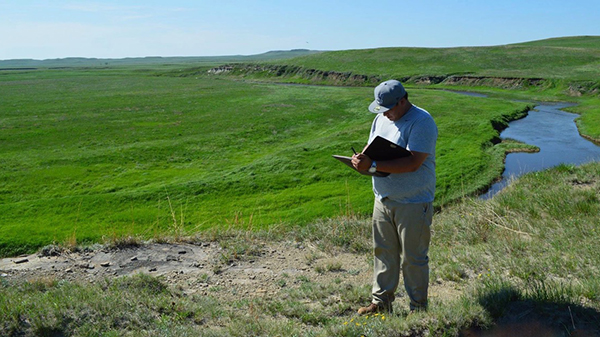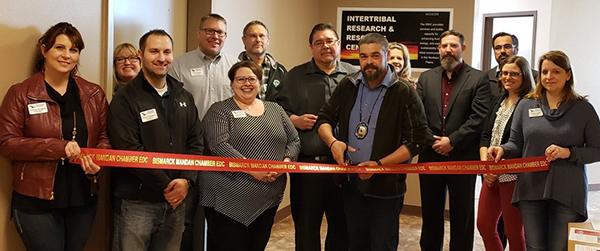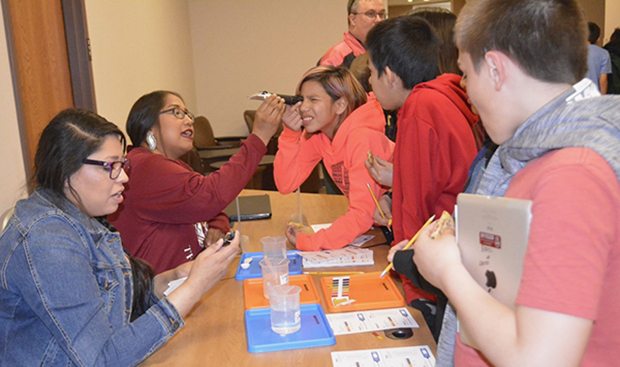United Tribes Technical College’s new intertribal research center will promote food, energy, and water sustainability within Native communities across the northern Plains
By Paul Boyer

United Tribes Technical College’s new intertribal research center officially opened earlier this month with a celebration featuring presentations by STEM faculty and science-related activities for the larger Bismarck, North Dakota community.
Founded in 1969, United Tribes Technical College (UTTC) initially emphasized vocational and professional training for Native American students in North Dakota. The college’s growing academic program now includes a wide range of STEM courses and degrees, including a four-year degree in Environmental Science and Research.
The college’s new Intertribal Research and Resource Center (IRRC) will significantly expand its instructional program and research capacity, said UTTC President Leander “Russ” McDonald.
“UTTC has a long history of serving as a resource for tribal nations throughout the Great Plains region,” he said. “The Intertribal Research and Resource Center builds on a strong network of partnerships to enhance research activities to positively impact land management and the sustainability of natural resources.”
The new center will focus on food, energy, and water sustainability—issues that are a priority for tribal communities in the northern Plains.
“Food and natural resources hold significant places for tribal communities’ economy, culture, sustainability, and sovereignty, and are often under studied,” said Jeremy Guinn, a member of the college’s faculty and the center’s director. “This project will, for the first time, allow us to expand our science beyond our academic program by bringing full-time research scientists and outreach specialists to work on natural resource issues directly affecting tribal communities,” he said.

Funding from the National Science Foundation allowed the college to hire two-full time research faculty, an outreach coordinator, and set up a sponsored programs office. The new staff include Gurjot “Gary” Dhaliwal, a research scientist, and Anna Bahnson, tribal science outreach coordinator. Research scientist Emily Biggane, who works in environmental toxicology, will join the staff full time this fall after finishing her PhD in biomedical sciences at the University of North Dakota.
Guinn said the research center’s work “will be immediately transformative” for the college. By developing what he called a “coordinated, interdisciplinary approach to research, outreach, teaching, and education” the college will have the capacity to study natural resource issues across the region and work more effectively with university and agency partners.
Once fully established, the center will also maintain an online repository for research, news, and case studies; conduct tribal food system and natural resource surveys; and develop integrated resource management plans for interested tribes.

The Intertribal Research and Resource Center is one of four Tribal Enterprise Advancement (TEA) centers funded by the National Science Foundation’s Tribal Colleges and Universities Program. Called the “first of their kind” by the NSF, the centers are intended to build research capacity within tribal communities and promote tribal economic development. TEA centers are also expected to build relationships across agencies and beyond reservation boundaries.
Community engagement was highlighted at the grand opening. Faculty and students from the college’s pre-engineering, land grant, and environmental science departments provided hands-on science activities for the public and students from the Theodore Jameson Elementary School, which is located on UTTC’s campus. Staff from Gateway to Science, a family-focused science center in Bismarck, also took part in opening day activities.
“Our vision is to inspire the next generation of STEM professionals,” said Bahnson. “By partnering with regional tribal K-12 and college students we seek to translate the research of the IRRC into engaging science programming.”
Paul Boyer is editor of Native Science Report
UTTC Outreach Coordinator Anna Bahnson and IRRC Director Jeremy Guinn also provided content for this article.
